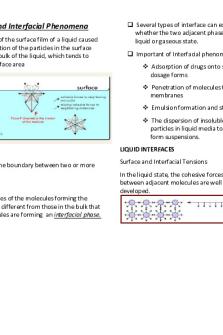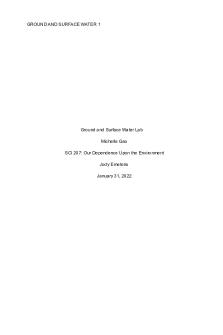Lesson 5 IMF and Wetting, Surface Tension, Capillary Action and Viscosity PDF

| Title | Lesson 5 IMF and Wetting, Surface Tension, Capillary Action and Viscosity |
|---|---|
| Course | General Chemistry I |
| Institution | The University of Texas at Arlington |
| Pages | 4 |
| File Size | 300.4 KB |
| File Type | |
| Total Downloads | 96 |
| Total Views | 123 |
Summary
Lesson 5 for interactions surface tension capillary action and viscosity....
Description
Intermolecular Forces of Attraction, Wetting, Surface Tension, Capillary Action and Viscosity Lesson 5 The molecular translational motion in liquid phase is neither free as in the gas phase nor highly restricted as in the solid phase because the intermolecular forces of attraction in liquids are moderately strong. Therefore, the molecules in liquids are loosely held, which allows them to slide past each other. The molecules , therefore, in the liquid phase are NOT as ordered as the molecules in the solid phase. Liquids exhibit various interesting behaviors such as (1) curved surface, (2) wetting, (c) surface tension, (b) capillary action, (c) viscosity, (d) vaporization, (e) vapor pressure, and (f) boiling. Let us consider each of of these properties. Liquid Meniscus Intermolecular forces of attraction such as dispersion, dipole-dipole, and H-bond are classified as adhesive or cohesive forces. Cohesive forces hold similar molecules. For example, the H-bond between two or more H2O molecules is cohesive. On the other hand, adhesive forces hold dissimilar molecules. The H-bond between H2O molecules and CH3OH molecules is adhesive. When a liquid is in contact with a surface, its behavior depends on whether the adhesive forces between the liquid molecules and the surface molecules are stronger than the cohesive forces of the liquid molecules. The curved surface of a liquid in a glass tube is called its meniscus. Liquids can form either a convex or concave meniscus. The shape of the meniscus depends on the relative strengths of the adhesive forces and the cohesive forces. If water is placed in a glass tube, it forms a concave meniscus because adhesive forces between water and the glass tube, which contains OH groups, are stronger than the cohesive forces in the liquid water (Fig. 1a). The strong attraction between water molecules and the glass molecules tend to pull up the water molecules in contact with the glass surface. In contrast, the surface of the liquid Hg bends downward because Hg atoms have no interest in interacting with the glass molecules. Since Hg atoms are held by a very strong attractive force called the metallic bond, they love to interact with each other. In this case, the cohesive force is stronger than the adhesive force. Thus, a convex meniscus is formed. We will discuss the nature of metallic bond in future lessons. Wetting Cohesive and adhesive forces are also responsible for the wetting phenomena dispayed by liquids. Wetting a surface means the liquid spread across a large area on the surface. The degree of wetting depends on the relative strengths of the cohesive forces in the liquid and the adhesive forces between the liquid and the surface. If the adhesive forces are stronger than the cohesive forces, the liquid wets the surface. However, when the cohesive forces are stronger than the adhesive forces, the liquid beads up.
1
Surface Tension The surface of a liquid is strained. This strain is called the surface tension. This tension is manifested by the tendency of the liquid to minimize its surface area. In other words, liquids tend to ball up due to surface tension. Surface tension occurs because the surface molecules and the bulk molecules experience an imbalance in the cohesive forces. Consider molecule A and molecule B in Figure 2. We label the molecules as A and B to distinguish their position in the molecule but they are identical Fig. 2 molecules. Molecule B is pulled to all directions by other molecules in the bulk. In other words, the molecule B experiences cohesive forces from everywhere. These opposing forces cancel each other. Thus, molecule B does not experience a net force. As a result, it does not feel any tension. Molecule A, on the other hand, is pulled only by molecules below the surface. There are no opposing cohesive forces above the surface of the liquids. The adhesive forces between the surface molecule and the atmospheric molecules are virtually nonexistent. Therefore, molecule A experiences an inward pull. This inward pull gives rise to the tension on the surface of the liquids, that permits the surface to behave like stretch cellophane or elastic membrane. This “membrane” permits small insect and thin wire to stay afloat on the liquid surface. The strength of the surface tension is measured by the amount of energy needed to spread out or increase the liquid surface by one unit area. The energy is typically measured in J/m2. The surface tension is affected by the strength of the intermolecular forces of attraction in the liquid. The stronger the IMF in molecules, the greater the surface tension. Consider pentane, ethanol, and glycerol in Table 1. The amount of energy needed to increase the surface of pentane is the smallest because pentane molecules interact by dispersion forces only. Therefore, the surface tension of pentane is the weakest. Table 1. Surface Tensions of Some Common Liquids Name Structure
Strength of IMF
Surface Tension (J/m2)
Weak
1.6110−2
Stronger
2.23 10−2
Strongest
6.34 10−2
Pentane - nonpolar molecule - ONLY dispersion force is present ethanol - nonpolar region and polar region are present - Dispersion, dipole-dipole, and H-bonding are present glycerol
- nonpolar region and polar region are present - Dispersion, dipole-dipole, and H-bonding from multiple sites
2
Effect of Temperature on the Surface Tension sing the temperature of the liquid increases the average kinetic energy of its molecules. The increased molecular motion weakens the IMF that holds the molecules in the liquid phase, which in turn, weakens the surface tension. Therefore, the liquid’s’ surface tension is weaker at high temperature.
Viscosity Liquids are fluid. But some liquids flow readily than others. Liquids that do not flow readily have high viscosity. Viscosity is a measure of the liquid’s resistance to flow or change in shape. Liquids with high viscosity are described as viscous. Viscosity is measured in Ns/m2. Molecules that are viscous have very strong intermolecular forces of attraction. In other words, liquid molecules that interact by strong intermolecular forces of attraction have very strong tendency to resist flow. Table 1 shows that the viscosity of glycerol is much higher than those of pentane and ethanol. The higher viscosity of glycerol is due to the ability of its molecules to interact by very strong H-bonding through its three O-H groups. Table 2 Viscosity of Some Common Liquids Name Structure Strength of Viscosity (kgm/s or IMF Ns/m2) Pentane - nonpolar molecule - ONLY dispersion force is present
Weakest
2.4 10−4
Stronger
1.2 10−3
Strongest
1.49
ethanol - nonpolar region and polar region are present - Dispersion, dipole-dipole, and H-bonding are present glycerol
- Dispersion, dipole-dipole, and H-bonding from multiple sites Effect of Temperature on Viscosity aising the temperature of a liquid reduces its viscosity because the increase in the average molecular motion makes it easier to overcome the intermolecular attractions. The liquid can easily flow at high temperatures.
3
Capillary Action Capillary action is the ability of a liquid to climb a capillary (small-diameter) tube against the influence of gravity. The smaller the diameter of the tube, the higher the liquid rises. How does Capillary Action Occur? Adhesive forces cause the water molecules to stick to the tube molecules, while the cohesive forces cause the liquid molecules to stick together. If the adhesive force is stronger than the cohesive force, the liquid molecules in direct contact with the wall of the tube are pulled upwards. The cohesive force then pulls the rest of the liquid molecules up in the tube as well. On the hand, if the adhesive force is weaker than the cohesive force, the liquid barely rises in the tube. If the adhesive force is significantly weaker than the cohesive force, the liquid does not rise at all. In some liquids, the level of the liquid in the tube is even lower than the level of the liquid outside the tube.
Summary: Effect of Intermolecular Forces of Attraction (MF) on the Properties of Liquids In general, the stronger the force of attraction, the larger is the energy required to break it. 1. Meniscus ➢ Concave meniscus forms when adhesive forces are stronger than the cohesive forces. 2. Wetting ➢ Liquids wets the surface when the adhesive forces are stronger than the cohesive forces. 3. Surface Tension ➢ The surface tension of the liquid is strong when its intermolecular forces are strong. 4. Viscosity ➢ The viscosity of a liquid is high when its intermolecular forces are strong. 5. Capillary Action ➢ A liquid rises higher in a capillary tube when the adhesion force between the liquid molecules and surface molecules are stronger that cohesive forces. Please watch this video summary. Sample Problem 1 Sample Problem 2 Self-assessment Problem 1. If the inside surface of the tube were coated with paraffin wax, would the general shape of the water meniscus remain concave? Note: paraffin wax is made up of long carbon-hydrogen chain. Problem 2. When a thin glass tube is put into water, the water rises 1.4 cm. When the same tube is put into hexane, the hexane, C6H14, rises only 0.4 cm. Note: the tube surface molecules contain~ OH −. Explain the difference in the capillary action of water and hexane.
Problem 3. Rank the following from least to most viscous.
4...
Similar Free PDFs

Surface Tension Report+Theory
- 14 Pages

Surface tension - Lecture notes 1
- 11 Pages

Capillary Puncture AND Equipment
- 3 Pages

corrosion and surface chemistry
- 615 Pages

Surface and Interfacial Phenomena
- 16 Pages

Tension and Repose Assignment 2
- 10 Pages

Cells and Action Potentials
- 3 Pages

Ground and Surface Water Lab
- 8 Pages

Intrinsic Viscosity
- 9 Pages

Viscosity
- 29 Pages

L06 - Hormone synthesis and action
- 13 Pages

Lesson 1 and Lesson 2
- 2 Pages
Popular Institutions
- Tinajero National High School - Annex
- Politeknik Caltex Riau
- Yokohama City University
- SGT University
- University of Al-Qadisiyah
- Divine Word College of Vigan
- Techniek College Rotterdam
- Universidade de Santiago
- Universiti Teknologi MARA Cawangan Johor Kampus Pasir Gudang
- Poltekkes Kemenkes Yogyakarta
- Baguio City National High School
- Colegio san marcos
- preparatoria uno
- Centro de Bachillerato Tecnológico Industrial y de Servicios No. 107
- Dalian Maritime University
- Quang Trung Secondary School
- Colegio Tecnológico en Informática
- Corporación Regional de Educación Superior
- Grupo CEDVA
- Dar Al Uloom University
- Centro de Estudios Preuniversitarios de la Universidad Nacional de Ingeniería
- 上智大学
- Aakash International School, Nuna Majara
- San Felipe Neri Catholic School
- Kang Chiao International School - New Taipei City
- Misamis Occidental National High School
- Institución Educativa Escuela Normal Juan Ladrilleros
- Kolehiyo ng Pantukan
- Batanes State College
- Instituto Continental
- Sekolah Menengah Kejuruan Kesehatan Kaltara (Tarakan)
- Colegio de La Inmaculada Concepcion - Cebu



